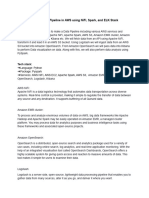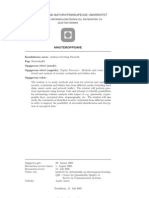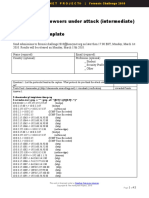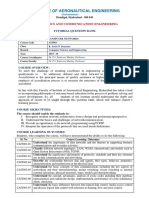Packet Analyzer
Packet Analyzer
Uploaded by
HarinisanthoshCopyright:
Available Formats
Packet Analyzer
Packet Analyzer
Uploaded by
HarinisanthoshOriginal Description:
Copyright
Available Formats
Share this document
Did you find this document useful?
Is this content inappropriate?
Copyright:
Available Formats
Packet Analyzer
Packet Analyzer
Uploaded by
HarinisanthoshCopyright:
Available Formats
Packet Analyzer: 15 TCPDUMP Command Examples
tcpdump command is also called as packet analyzer.
tcpdump command will work on most flavors of unix operating system. tcpdump
allows us to save the packets that are captured, so that we can use it for future
analysis. The saved file can be viewed by the same tcpdump command. We can also
use open source software like wireshark to read the tcpdump pcap files.
In this tcpdump tutorial, let us discuss some practical examples on how to use the
tcpdump command.
1. Capture packets from a particular ethernet interface using
tcpdump -i
When you execute tcpdump command without any option, it will capture all the
packets flowing through all the interfaces. -i option with tcpdump command, allows
you to filter on a particular ethernet interface.
$ tcpdump -i eth1
14:59:26.608728 IP xx.domain.netbcp.net.52497 > valh4.lell.net.ssh: . ack 540 win
16554
14:59:26.610602 IP resolver.lell.net.domain > valh4.lell.net.24151: 4278 1/0/0 (73)
14:59:26.611262 IP valh4.lell.net.38527 > resolver.lell.net.domain: 26364+ PTR?
244.207.104.10.in-addr.arpa. (45)
In this example, tcpdump captured all the packets flows in the interface eth1 and
displays in the standard output.
Note: Editcap utility is used to select or remove specific packets from dump file and
translate them into a given format.
2. Capture only N number of packets using tcpdump -c
When you execute tcpdump command it gives packets until you cancel the tcpdump
command. Using -c option you can specify the number of packets to capture.
$ tcpdump -c 2 -i eth0
listening on eth0, link-type EN10MB (Ethernet), capture size 96 bytes
14:38:38.184913 IP valh4.lell.net.ssh > yy.domain.innetbcp.net.11006: P
1457255642:1457255758(116) ack 1561463966 win 63652
14:38:38.690919 IP valh4.lell.net.ssh > yy.domain.innetbcp.net.11006: P 116:232(116)
ack 1 win 63652
2 packets captured
13 packets received by filter
0 packets dropped by kernel
The above tcpdump command captured only 2 packets from interface eth0.
Note: Mergecap and TShark: Mergecap is a packet dump combining tool, which will
combine multiple dumps into a single dump file. Tshark is a powerful tool to capture
network packets, which can be used to analyze the network traffic. It comes with
wireshark network analyzer distribution.
3. Display Captured Packets in ASCII using tcpdump -A
The following tcpdump syntax prints the packet in ASCII.
$ tcpdump -A -i eth0
tcpdump: verbose output suppressed, use -v or -vv for full protocol decode
listening on eth0, link-type EN10MB (Ethernet), capture size 96 bytes
14:34:50.913995 IP valh4.lell.net.ssh > yy.domain.innetbcp.net.11006: P
1457239478:1457239594(116) ack 1561461262 win 63652
E.....@.@..]..i...9...*.V...]...P....h....E...>{..U=...g.
......G..7\+KA....A...L.
14:34:51.423640 IP valh4.lell.net.ssh > yy.domain.innetbcp.net.11006: P 116:232(116)
ack 1 win 63652
E.....@.@..\..i...9...*.V..*]...P....h....7......X..!....Im.S.g.u:*..O&....^#Ba...
E..(R.@.|.....9...i.*...]...V..*P..OWp........
Note: Ifconfig command is used to configure network interfaces
4. Display Captured Packets in HEX and ASCII using tcpdump
-XX
Some users might want to analyse the packets in hex values. tcpdump provides a way
to print packets in both ASCII and HEX format.
$tcpdump -XX -i eth0
18:52:54.859697 IP zz.domain.innetbcp.net.63897 > valh4.lell.net.ssh: . ack 232 win
16511
0x0000: 0050 569c 35a3 0019 bb1c 0c00 0800 4500 .PV.5.........E.
0x0010: 0028 042a 4000 7906 c89c 10b5 aaf6 0f9a .(.*@.y.........
0x0020: 69c4 f999 0016 57db 6e08 c712 ea2e 5010 i.....W.n.....P.
0x0030: 407f c976 0000 0000 0000 0000
@..v........
18:52:54.877713 IP 10.0.0.0 > all-systems.mcast.net: igmp query v3 [max resp time 1s]
0x0000: 0050 569c 35a3 0000 0000 0000 0800 4600 .PV.5.........F.
0x0010: 0024 0000 0000 0102 3ad3 0a00 0000 e000 .$......:.......
0x0020: 0001 9404 0000 1101 ebfe 0000 0000 0300 ................
0x0030: 0000 0000 0000 0000 0000 0000
............
5. Capture the packets and write into a file using tcpdump -w
tcpdump allows you to save the packets to a file, and later you can use the packet file
for further analysis.
$ tcpdump -w 08232010.pcap -i eth0
tcpdump: listening on eth0, link-type EN10MB (Ethernet), capture size 96 bytes
32 packets captured
32 packets received by filter
0 packets dropped by kernel
-w option writes the packets into a given file. The file extension should be .pcap,
which can be read by any network protocol
analyzer.
6. Reading the packets from a saved file using tcpdump -r
You can read the captured pcap file and view the packets for analysis, as shown
below.
$tcpdump -tttt -r data.pcap
2010-08-22 21:35:26.571793 00:50:56:9c:69:38 (oui Unknown) > Broadcast, ethertype
Unknown (0xcafe), length 74:
0x0000: 0200 000a ffff 0000 ffff 0c00 3c00 0000 ............<...
0x0010: 0000 0000 0100 0080 3e9e 2900 0000 0000 ........>.).....
0x0020: 0000 0000 ffff ffff ad00 996b 0600 0050 ...........k...P
0x0030: 569c 6938 0000 0000 8e07 0000
V.i8........
2010-08-22 21:35:26.571797 IP valh4.lell.net.ssh > zz.domain.innetbcp.net.50570: P
800464396:800464448(52) ack 203316566 win 71
2010-08-22 21:35:26.571800 IP valh4.lell.net.ssh > zz.domain.innetbcp.net.50570: P
52:168(116) ack 1 win 71
2010-08-22 21:35:26.584865 IP valh5.lell.net.ssh > 11.154.12.255.netbios-ns: NBT UDP
PACKET(137): QUERY; REQUEST; BROADC
7. Capture packets with IP address using tcpdump -n
In all the above examples, it prints packets with the DNS address, but not the ip
address. The following example captures the packets and it will display the IP
address of the machines involved.
$ tcpdump -n -i eth0
15:01:35.170763 IP 10.0.19.121.52497 > 11.154.12.121.ssh: P 105:157(52) ack 18060
win 16549
15:01:35.170776 IP 11.154.12.121.ssh > 10.0.19.121.52497: P 23988:24136(148) ack
157 win 113
15:01:35.170894 IP 11.154.12.121.ssh > 10.0.19.121.52497: P 24136:24380(244) ack
157 win 113
8. Capture packets with proper readable timestamp using
tcpdump -tttt
$ tcpdump -n -tttt -i eth0
2010-08-22 15:10:39.162830 IP 10.0.19.121.52497 > 11.154.12.121.ssh: . ack 49800
win 16390
2010-08-22 15:10:39.162833 IP 10.0.19.121.52497 > 11.154.12.121.ssh: . ack 50288
win 16660
2010-08-22 15:10:39.162867 IP 10.0.19.121.52497 > 11.154.12.121.ssh: . ack 50584
win 16586
9. Read packets longer than N bytes
You can receive only the packets greater than n number of bytes using a filter
greater through tcpdump command
$ tcpdump -w g_1024.pcap greater 1024
10. Receive only the packets of a specific protocol type
You can receive the packets based on the protocol type. You can specify one of these
protocols fddi, tr, wlan, ip, ip6, arp, rarp, decnet, tcp and udp. The following
example captures only arp packets flowing through the eth0 interface.
$ tcpdump -i eth0 arp
tcpdump: verbose output suppressed, use -v or -vv for full protocol decode
listening on eth0, link-type EN10MB (Ethernet), capture size 96 bytes
19:41:52.809642 arp who-has valh5.lell.net tell valh9.lell.net
19:41:52.863689 arp who-has 11.154.12.1 tell valh6.lell.net
19:41:53.024769 arp who-has 11.154.12.1 tell valh7.lell.net
11. Read packets lesser than N bytes
You can receive only the packets lesser than n number of bytes using a filter less
through tcpdump command
$ tcpdump -w l_1024.pcap less 1024
12. Receive packets flows on a particular port using tcpdump port
If you want to know all the packets received by a particular port on a machine, you
can use tcpdump command as shown below.
$ tcpdump -i eth0 port 22
19:44:44.934459 IP valh4.lell.net.ssh > zz.domain.innetbcp.net.63897: P
18932:19096(164) ack 105 win 71
19:44:44.934533 IP valh4.lell.net.ssh > zz.domain.innetbcp.net.63897: P
19096:19260(164) ack 105 win 71
19:44:44.934612 IP valh4.lell.net.ssh > zz.domain.innetbcp.net.63897: P
19260:19424(164) ack 105 win 71
13. Capture packets for particular destination IP and Port
The packets will have source and destination IP and port numbers. Using tcpdump
we can apply filters on source or destination IP and port number. The following
command captures packets flows in eth0, with a particular destination ip and port
number 22.
$ tcpdump -w xpackets.pcap -i eth0 dst 10.181.140.216 and port 22
14. Capture TCP communication packets between two hosts
If two different process from two different machines are communicating through tcp
protocol, we can capture those packets using tcpdump as shown below.
$tcpdump -w comm.pcap -i eth0 dst 16.181.170.246 and port 22
You can open the file comm.pcap using any network protocol analyzer tool to debug
any potential issues.
15. tcpdump Filter Packets Capture all the packets other than
arp and rarp
In tcpdump command, you can give and, or and not condition to filter the
packets accordingly.
$ tcpdump -i eth0 not arp and not rarp
20:33:15.479278 IP resolver.lell.net.domain > valh4.lell.net.64639: 26929 1/0/0 (73)
20:33:15.479890 IP valh4.lell.net.16053 > resolver.lell.net.domain: 56556+ PTR?
255.107.154.15.in-addr.arpa. (45)
20:33:15.480197 IP valh4.lell.net.ssh > zz.domain.innetbcp.net.63897: P 540:1504(964)
ack 1 win 96
20:33:15.487118 IP zz.domain.innetbcp.net.63897 > valh4.lell.net.ssh: . ack 540 win
16486
20:33:15.668599 IP 10.0.0.0 > all-systems.mcast.net: igmp query v3 [max resp time 1s]
You might also like
- NIT2222 Networking Technologies Assignment 1Document43 pagesNIT2222 Networking Technologies Assignment 1Syaela Rahma100% (1)
- CyberOps v1.1 Instructor Game InstructionsDocument6 pagesCyberOps v1.1 Instructor Game InstructionsozsaNo ratings yet
- Sniffing SpoofingDocument6 pagesSniffing SpoofingDeTRoyDNo ratings yet
- PHP SecurityDocument89 pagesPHP Securitymovs681221No ratings yet
- Exam Questions 300-430: Implementing Cisco Enterprise Wireless Networks (ENWLSI)Document6 pagesExam Questions 300-430: Implementing Cisco Enterprise Wireless Networks (ENWLSI)Lucho BustamanteNo ratings yet
- Packet CaptureDocument32 pagesPacket CapturefqchinaNo ratings yet
- CN 422-Week#3 Lect-Packet Capture and AnalysisDocument31 pagesCN 422-Week#3 Lect-Packet Capture and AnalysisITtickeiNo ratings yet
- Technical Support What Are The Main Responsibilities?Document6 pagesTechnical Support What Are The Main Responsibilities?Orlando NajeraNo ratings yet
- Java (Networking) (Jpcap: Capturing and Displaying Packet Traffic With Jpcapcapturepacket and Receivepacket)Document3 pagesJava (Networking) (Jpcap: Capturing and Displaying Packet Traffic With Jpcapcapturepacket and Receivepacket)Nguyễn Văn DũngNo ratings yet
- Packet Sniffing: - by Aarti DhoneDocument13 pagesPacket Sniffing: - by Aarti Dhonejaveeed0401No ratings yet
- Network Monitoring Analysis Using Wireshark Tools (Term Project)Document19 pagesNetwork Monitoring Analysis Using Wireshark Tools (Term Project)Md. Anisur RahmanNo ratings yet
- Project Report of A Packet Sniffer ProgrDocument3 pagesProject Report of A Packet Sniffer ProgrSayantan100% (1)
- Pipeline Nifi Aws ElkDocument2 pagesPipeline Nifi Aws ElkBigData LilleNo ratings yet
- 5.4.3.4 Lab - Use Wireshark To Compare Telnet and SSH Traffic-SAPARUDDINDocument5 pages5.4.3.4 Lab - Use Wireshark To Compare Telnet and SSH Traffic-SAPARUDDINSMK LimboroNo ratings yet
- Dzone2018 Researchguide PerformanceDocument37 pagesDzone2018 Researchguide PerformancejastazvNo ratings yet
- Network Monitoring and Analysis by Packet Sniffing MethodDocument3 pagesNetwork Monitoring and Analysis by Packet Sniffing MethodseventhsensegroupNo ratings yet
- MQ v9.0 RequirementsDocument94 pagesMQ v9.0 Requirementsmur2zaNo ratings yet
- Performance Monitoring Essentials Elasticsearch Edition PDFDocument36 pagesPerformance Monitoring Essentials Elasticsearch Edition PDFIT 2MINo ratings yet
- High Performance Trading - FIX Messaging Testing For Low LatencyDocument24 pagesHigh Performance Trading - FIX Messaging Testing For Low LatencysmallakeNo ratings yet
- Wireshark TipsDocument40 pagesWireshark TipsAn TranNo ratings yet
- Lab Wireshark Packet Capture Assignment TutorialDocument8 pagesLab Wireshark Packet Capture Assignment TutorialHaseeb RazaNo ratings yet
- Digital Forensics Methods and Tools For Retrieval and Analysis of Security Credentials and Hidden DataDocument131 pagesDigital Forensics Methods and Tools For Retrieval and Analysis of Security Credentials and Hidden Dataturbochan5530No ratings yet
- Opennebula 5.6 Deployment Guide: Release 5.6.2Document224 pagesOpennebula 5.6 Deployment Guide: Release 5.6.2darkd76nsNo ratings yet
- 2.3.2.6 Packet Tracer - Using Wireshark To View Network TrafficDocument17 pages2.3.2.6 Packet Tracer - Using Wireshark To View Network TrafficParthPatelNo ratings yet
- Packet SniffingDocument38 pagesPacket SniffingSatyabrata MoharanaNo ratings yet
- IT Server Security Cheat SheetDocument35 pagesIT Server Security Cheat SheetMahesha CukkemaneNo ratings yet
- WWW - Hackingarticles.in: Page - 1Document46 pagesWWW - Hackingarticles.in: Page - 1Jay SingireddyNo ratings yet
- Enterprise VoIP Solutions With Alpine Linux - Slashroots 2011Document47 pagesEnterprise VoIP Solutions With Alpine Linux - Slashroots 2011SlashRootsNo ratings yet
- Forensic Challenge 2010 - Challenge - 2 - SolutionDocument43 pagesForensic Challenge 2010 - Challenge - 2 - SolutionMehdi Sfar100% (1)
- Leon Trappett Email: Twitter: Site: Linkedin: Experience Silent Break Security, Pleasant Grove, UtDocument2 pagesLeon Trappett Email: Twitter: Site: Linkedin: Experience Silent Break Security, Pleasant Grove, UtAnonymous YmxXyvRC1dNo ratings yet
- Getting Started With Tivoli Dynamic Workload Broker Version 1.1 Sg247442Document706 pagesGetting Started With Tivoli Dynamic Workload Broker Version 1.1 Sg247442bupbechanhNo ratings yet
- System Center 2012 R2 Virtual Machine Manager CookbookFrom EverandSystem Center 2012 R2 Virtual Machine Manager CookbookNo ratings yet
- Web SecurityDocument16 pagesWeb SecurityhussamNo ratings yet
- Routing Concept: Sirak KaewjamnongDocument45 pagesRouting Concept: Sirak KaewjamnongAjay BarwalNo ratings yet
- NPM GuideDocument92 pagesNPM Guidebelalr84No ratings yet
- Lotus-Domino-Designer Programming Guide Vol1Document693 pagesLotus-Domino-Designer Programming Guide Vol1Pettrie De Bondt100% (1)
- Presentation On "Network Miner": Presented byDocument3 pagesPresentation On "Network Miner": Presented byRehan Umar Khan100% (1)
- Basic of NetworkingDocument46 pagesBasic of Networkingapi-281601506No ratings yet
- PCAP Level I Bootcamp Rev 8.21Document12 pagesPCAP Level I Bootcamp Rev 8.21P-CAPNo ratings yet
- Using Wireshark AnswersDocument9 pagesUsing Wireshark AnswersFranch Maverick Arellano LorillaNo ratings yet
- Extracting Data From Lotus Notes and DominoDocument20 pagesExtracting Data From Lotus Notes and Dominowhatever_no_idea5191No ratings yet
- 1.1.1.4 Lab Installing The CyberOps Workstation Virtual MachineDocument4 pages1.1.1.4 Lab Installing The CyberOps Workstation Virtual MachineAayuliii100% (4)
- SOP - Sign Cap SoftwareDocument13 pagesSOP - Sign Cap SoftwarePranav Jadav50% (2)
- Micro Focus Security Arcsight Connectors: Smartconnector For Fortinet Fortigate Syslog Configuration GuideDocument16 pagesMicro Focus Security Arcsight Connectors: Smartconnector For Fortinet Fortigate Syslog Configuration GuideamitNo ratings yet
- XSS Prevention NotesDocument5 pagesXSS Prevention NotesPawan Kumar PulivarthiNo ratings yet
- Lotus Notes and DominoDocument523 pagesLotus Notes and Dominoapi-3722405No ratings yet
- Java Self-Evaluation FormDocument5 pagesJava Self-Evaluation FormYurii ProrokNo ratings yet
- IPV6 For CCNADocument32 pagesIPV6 For CCNADo Hieu100% (6)
- Configuring IPCop Firewalls: Closing Borders with Open SourceFrom EverandConfiguring IPCop Firewalls: Closing Borders with Open SourceNo ratings yet
- SmartSniff - Packet Sniffer - Capture TCP-IP Packets On Your Network AdapterDocument9 pagesSmartSniff - Packet Sniffer - Capture TCP-IP Packets On Your Network AdapterdrukovNo ratings yet
- Your UNIX Linux The Ultimate Guide 3rd Edition by Sumitabha Solution ManualDocument1 pageYour UNIX Linux The Ultimate Guide 3rd Edition by Sumitabha Solution ManualAasif Wani0% (1)
- Wireshark Lab: ICMPDocument2 pagesWireshark Lab: ICMPمحمد عيدNo ratings yet
- Network Protocols: HandbookDocument20 pagesNetwork Protocols: Handbookromario1102No ratings yet
- Linux Elevation of Privileges, Manual Testing: Sudo SuDocument4 pagesLinux Elevation of Privileges, Manual Testing: Sudo SuANELKAOSNo ratings yet
- Centos Server Configuration A-Z PDFDocument70 pagesCentos Server Configuration A-Z PDFMarina Derrude100% (1)
- Meraki Solution Guide: Layer 3 Roaming: Version 1.0, July 2012Document9 pagesMeraki Solution Guide: Layer 3 Roaming: Version 1.0, July 2012Oscar EstradaNo ratings yet
- Enterprise Search Using Elastic SearchDocument36 pagesEnterprise Search Using Elastic SearchVaibhav NautiyalNo ratings yet
- AWS Advanced Networking - Specialty Sample Exam QuestionsDocument4 pagesAWS Advanced Networking - Specialty Sample Exam Questionsraghs4uNo ratings yet
- Big Data Analytics - A Hands-On Approach (PDFDrive) (1) - 35-42Document8 pagesBig Data Analytics - A Hands-On Approach (PDFDrive) (1) - 35-42Vikas VermaNo ratings yet
- Policy-Based Routing On Fortigate Firewall - Plain Tutorials PDFDocument5 pagesPolicy-Based Routing On Fortigate Firewall - Plain Tutorials PDFkflimNo ratings yet
- 6.5.2.3 Packet Tracer-ResueltoDocument2 pages6.5.2.3 Packet Tracer-ResueltoKaty Lucero Ccallo ObregonNo ratings yet
- Public Key Infrastructure: Jim HurstDocument5 pagesPublic Key Infrastructure: Jim HurstBARNALI GUPTANo ratings yet
- V8102 Dasan Training GPON 2015nov Session1Document41 pagesV8102 Dasan Training GPON 2015nov Session1Nguyễn Ninh100% (1)
- ACN MICRO PROJECTfinalDocument23 pagesACN MICRO PROJECTfinal1213 Vaibhav KothareNo ratings yet
- DS-2CD1143G0E-I 4 MP EXIR Fixed Dome Network CameraDocument5 pagesDS-2CD1143G0E-I 4 MP EXIR Fixed Dome Network CameraServconnet CLtdaNo ratings yet
- (Updated Constantly) : CCNA 1 (v5.1 + v6.0) Chapter 3 Exam Answers FullDocument15 pages(Updated Constantly) : CCNA 1 (v5.1 + v6.0) Chapter 3 Exam Answers FullDaniel NunesNo ratings yet
- Latest Cisco EnsurePass 640 911 Dumps PDFDocument43 pagesLatest Cisco EnsurePass 640 911 Dumps PDFkyaw100% (1)
- Sans GCFW Exam NotesDocument23 pagesSans GCFW Exam NotesitsaNo ratings yet
- Cloudflare Security Services: App Vulnerability Attacks GatewayDocument2 pagesCloudflare Security Services: App Vulnerability Attacks GatewayRJ KavinNo ratings yet
- SDM Data SheetDocument12 pagesSDM Data SheetTamerNo ratings yet
- CN QB 18-12-18 - 0Document8 pagesCN QB 18-12-18 - 0VigneshNo ratings yet
- Twilio UCM61xx Configuration1!24!2017Document14 pagesTwilio UCM61xx Configuration1!24!2017Aroldo ZelayaNo ratings yet
- Spcore101 SG Vol2Document196 pagesSpcore101 SG Vol2RobertNo ratings yet
- VPN - Direct Connection Using The 2ndDocument18 pagesVPN - Direct Connection Using The 2ndmozzpunkzNo ratings yet
- 10.1.4.4 Lab - Troubleshooting DHCPv4Document9 pages10.1.4.4 Lab - Troubleshooting DHCPv4YOGESWARAN A/L NATHANNo ratings yet
- Pregunta 2Document31 pagesPregunta 2Andre HuaweiNo ratings yet
- RFC 8365Document34 pagesRFC 8365Liz Mar CieloNo ratings yet
- Fortinet - Premium.nse6 .By .VCEplus.23q DEMO PremiumDocument10 pagesFortinet - Premium.nse6 .By .VCEplus.23q DEMO PremiumEric ROTICHNo ratings yet
- Simple Guide For RMONDocument8 pagesSimple Guide For RMONVinicius MalheirosNo ratings yet
- BNG CiscoDocument10 pagesBNG CiscoangelpyNo ratings yet
- Modul B - Network Systems - Itnsa - LKSN 2021Document5 pagesModul B - Network Systems - Itnsa - LKSN 2021DEMERIA BUTARBUTARNo ratings yet
- Read This Also-Configuring Cisco Stackwise VirtualDocument26 pagesRead This Also-Configuring Cisco Stackwise Virtualzamis aliNo ratings yet
- Ejercicio Tabla EnrutamientoDocument2 pagesEjercicio Tabla EnrutamientoRoberto Rojo Del PradoNo ratings yet
- SOLUTIONS of Assignment For Computer Network-IIDocument4 pagesSOLUTIONS of Assignment For Computer Network-IIIshu MiglaniNo ratings yet
- FSP 150 Ge 100 Pro SeriesDocument5 pagesFSP 150 Ge 100 Pro SeriesselvscribdNo ratings yet
- Topic 5.1 - EthernetDocument11 pagesTopic 5.1 - EthernetKevin NdyabandihoNo ratings yet

























































































